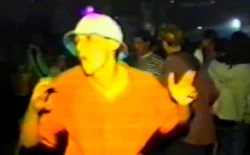01: STEVIE WONDER
‘RACE BABBLING’
(from STEVIE WONDER’S JOURNEY THROUGH THE SECRET LIFE OF PLANTS, MOTOWN LP, 1979)
Andy Butler: “The first time I got to hear this was on a kind of a cosmic disco mix put out by Alex from In Flagranti. Honestly, it was kind of confusing to me – I think he played it out of ‘Magnifique’. You know ‘Magnifique’: Baldelli did a re-edit of it, and it has these really bouncing, percolating acid synthesizers. Then out of this came this incredibly musical tune, with this real synthesizer wizardry but still maintaining that Moroderish quality. Maybe it’s too simplistic to call it Moroderish or Cowleyish, because they weren’t the only one’s doing it – sequential bass, that funk element.
“Anyway, then a vocal came in – put through some kind of effect – and I couldn’t understand what it was saying. I thought: this fucking track is unbelievable. What the fuck is this track? It really, really makes me dance.
“So I had to do a bit of research. You know, what’s awesome about Alex and why they [In Flagranti] deserve so much respect, is that they put out those cosmic disco mixes and they actually listed the songs they played…I was like I was 19 or 20 years old, I was going to art history class in the city and it was one block away from Alex’s record shop. I finally went in and talked to him and Linda Lamb and they were a little weird but very kind to me…I bought one of the tapes, found out the track was Race Babbling, and found out it was on [Stevie Wonder’s Jouney Through The] Secret Life of Plants, and I thought that was the weirdest thing.
“There are musos who think they can dismiss Stevie – which to me is insane, some of his albums are the most solid albums that were produced ever. So for me to say he’s an influence Is hard – because I feel I pale so hard in comparison to the musicality that’s embedded in his playing and singing. Stevie’s an influence on Hercules in that he’s a power of example…someone who’s had major struggle, overcame it, and written some of the most beautiful songs in the world about it.”
02: MYA & THE MIRROR
‘HESITATION’
(FUZZ DANCE 12”, 1984)
“I first heard this alongside Alexander Robotnick’s ‘Problemes d’amour’. They put out an EP track with four tracks on and the only one I really digged was the Mya track…it’s got this super Chris & Cosey-style synth line, very cold wavey, industrial sounding; then the kick comes in and you get almost a broken beat but still something 4/4 and the chorus arrives and you get the most unexpected thing: a saxophone. Being Hercules, the guy who likes to incorporate an odd instrument here and there, it fits really well.
“It also has a certain darkness…Mya sounds like she has a gothic thing going on, there’s the minor key that shifts into major. It’s also really playable for DJs: great intro, great outro.
“House music was introduced to around the age of 14 or 15, when I was starting to hear ambient techno and more mass-produced things, that moment in ’93-‘94 when techno was something. I really started to get into underground house music, like the New York guys – Louis Vega, Wild Pitch Crew, DJ Duke – and some of the more soulful garage stuff. The San Francisco sound was also a huge influence: Tonka Soundsystem offered the link between Baldelli and cosmic disco to italo and contemporary house music. When I was 17-years-old, I heard a mix from DJ Garth, called Ride The Rhythm, in which he was playing stuff from Prelude Records, an amazing Bill Withers track, the good Italian house – and there must have been some italo on there too.
“But my formal education and introduction to italo officially came when I was dating Derrick Carter. I was a 19-year-old, and he was playing tracks like Tullio de Piscopo’s ‘Stop Bajon’. That was when I started collected disco more generally too. I got so sick of hearing a loop of Chic song and I wanted to hear the original Chick song. A couple of years later I stumbled across an entire italo disco collection in a New York shop that doesn’t exist anymore called Heartbeat. I picked up like 90 records and got into that sound in a real hardcore way. Then It became OK, now I know. Now I know what I want.”
03: THE B-52s
‘DEEP SLEEP’
(from MESOPOTAMIA, WARNER/ISLAND LP, 1982)
“I was born in ‘78. ‘Loveshack’ was my first introduction to the B52s. I wasn’t around for ‘Planet Care’ or ‘Lobster rock’ or any of that bullshit…I mean, it’s not bullshit in retrospect, it’s totally fun. But when Mesopotamia was first introduced to me I had a whole new understanding and respect for them.
“The first time I heard ‘Deep Sleep’ was at Body & Soul around ‘97 – Danny or Francois played it. I found myself dancing next to the most beautiful African-American girl and we were just going OFF. So I bought the album. It had this strange modal quality to it, almost like it was Middle Eastern. It had almost a drug-like, trance-inducing effect, I was totally driven by it – because I was really getting into mid-tempo disco and slow-disco and really into that in-between period when things were just confusing and New York was a place of punk, disco and everything co-existing. I just find it extremely seductive and charming, I remember putting it on a mix CD, and playing it in the restaurant I was working in at the time. Kate Person [from The B-52s] came into the restaurant and she grabbed me and said ‘NO ONE LISTENS TO THIS SONG. I ALWAYS LOVED THE SONG AND IT NEVER GOT THE APPRECIATION IT DESERVED.’ So that was pretty gratifying…
“’Deep Sleep’ was a clear inspiration on something like ‘Blue Songs’ – a certain loping, exotic atmosphere, the lyrics are a little drifting.
“Also, The B-52s are one of the only bands that said, every time they played, ‘Guess what motherfuckers? Let’s have a fucking party!’ Yeah, when I think about it they’ve hugely influential on Hercules & Love Affair’s live performances.”
04: TERRY HUNTER FEAT. SHARON JARVIS
‘I CAN MAKE YOU SEE’ (AARON’S DEEP TWIRL MIX)
(HOUSE JAM 12”, 1991)
This track I discovered as a white label, and inititally I didn’t know it was Terry Hunter, even though I had some of his other material. It has these dissonant bells, which are really haunting, a certain melancholy, and then you hear Sharon Jarvis singing and the sadness becomes very…tangible. She’s saying, ‘I’ll make you see that I will always be there’ and she has this kind of freestyle voice…House music has always been about vocalists who have never been trained but who were kind of born to sing, like our own Shaun Wright.
“The ring of the bells back and forth, and the depth of the vocal, but also Terry Hunter’s beats…you play it at 4am and if you’ve had the crowd the whole night you’re going to get a serious emotional response from this track. It’s one of my favourite secret weapons; it’s the kind of record I play at home when I want to feel a certain way, be free and move around. I think the vocal performance is really, really good It just has thiat kind of raw house feel of the early days…it’s on House Jam, it’s a fucking deep track.
There was an elegance, subtlety, a sophistication to ’85’-’94 house…it was fine art. The depth and substance is unparalleled. I don’t think anything goes as deep as those early Murk records, for example. Nor do you get the opposite. You don’t get to hear people go off in the way Tyree did, you know, going off but classily.”
05: RON TRENT
‘DARK ROOM’
(BALANCE 12”, 1995)
“My favourite track is ‘Seduction’ – it’s not an easy track to play , it fades in rather than out, so you really have to find the first kick, it has a beautiful vocal sample, with the male vocal saying ‘SEDUCTION’. It just has all the right notes, simple notes played in the right way with this polyrhythmic thing going on.
“Again, if you played this one at 5am, it would really bring out the emotion. Ron Trent with Chez I just love – I wanted to include my all-time favourite house trak which is 054 on KMS Records [sings the melody], – that song to me is the most definitive, substantial deep house track. There’s nothing more primal, raw, deep and direct as that. But I included ‘The Dark Room’ because it’s a little more overlooked.”
















![Ryoji Ikeda installation data-cosm [n°1] extended at 180 Studios until 1 February, 2026](https://factmag-images.s3.amazonaws.com/wp-content/uploads/2025/12/data-cosm-ALubbock_180-14Oct-3554-250x155.webp)
![180 Studios presents new Ryoji Ikeda installation, data-cosm [n°1]](https://factmag-images.s3.amazonaws.com/wp-content/uploads/2025/10/ryoji-ikeda-data-cosm-1-250x155.webp)
















